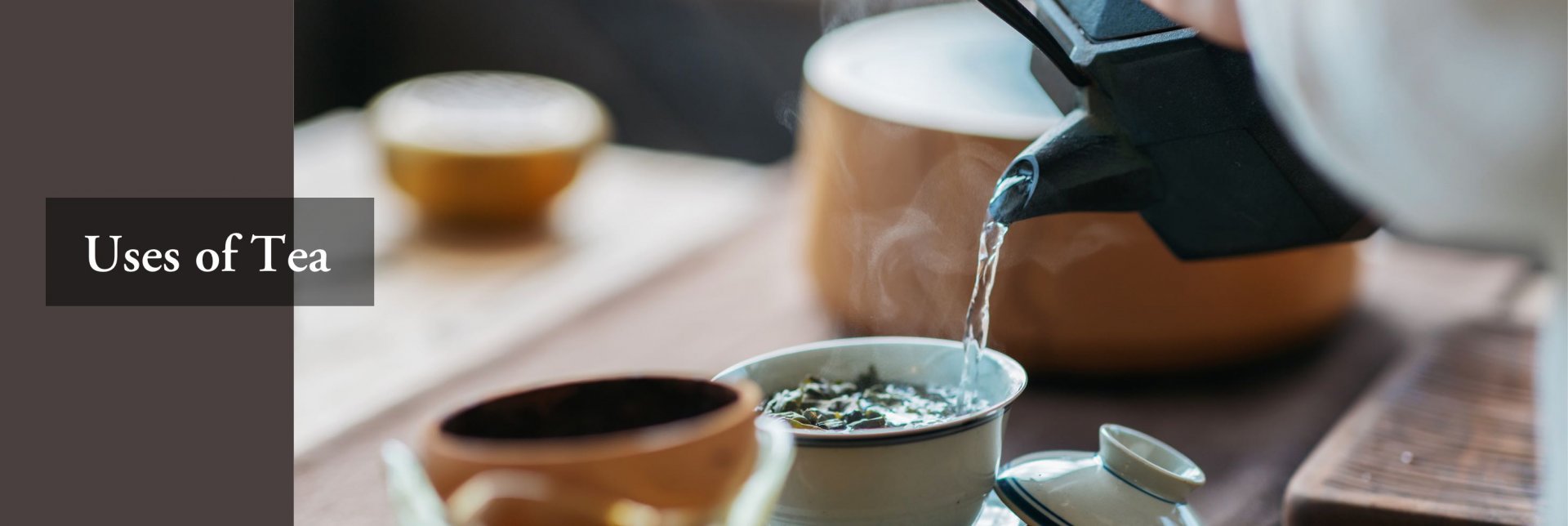Uses of Tea

Tea leaves are so mysterious that they have been active along the history from the legendary time of Shennong神农氏 till the present, appearing in the tea cups of the people from the royals to the commoners.

The uses of tea mainly come in four areas: food, medicine, sacrifice and drink.
Tea was initially introduced into human lives as food because the primary tasks of the primitive people living with poor conditions were to fill their stomachs during the age of Shennong. The primitive people tried to expand their varieties of food by collecting multiple kinds of plants and consuming all the roots, stems, leaves, flowers and fruits to satisfy their hunger as long as they were not poisonous. The ancestors were described as “due to the lack of fire, people had to eat the plants and grass and the raw meat of birds and beasts and even drink the blood and wear the skins of their prey.”

Since tea leaves are edible, some ethnic minorities have been employing them in their cooking such as the Pounded Tea 擂茶 of Hakka people客家人 made by mixing the peanuts, sesame seeds, and tea, Oil Tea (alias Youcha in Chinese pinyin) 油茶 of the Dong people made by sautéing tea leaves in oil and the cold blend tea of the Ji’nuo people 基诺族 that blended with the raw tea leaves, orange blossoms, raw garlic cloves, and ground peppercorns as well as local chili peppers.
The medical functions of tea had also been gradually discovered. Long-term harvesting and uses of the plants led the ancestors to examine the medical value of tea as there were numerous classics about medicine and tea in history.
The classics recorded that, “Shennong had tasted over a hundred types of grass and got poisoned about seventy-two times one day, then he consumed tea leaves which resolved the toxin.” Shennong got poisoned after tasting many types of grass, then he grabbed a few leaves next to him and put inside his mouth to chew, and accidentally found that the tea leaves were antidotes.
The practice of using tea for sacrifice could be probably dated back to Jin Dynasties (266-420). The Book of Southern Qi (《南齊書‧武帝蕭賾紀》) recorded that “our God won’t allow livestock to be butchered intentionally as sacrifices, but he accepts bread, tea, rice and preserved meat and wine. Regardless of the social status of the people, they should all follow this rule.” It reflected the worship of plants of the agricultural civilizations, and also implied their kind bearing of nonkilling.
Tea was used as soup since the Spring and Autumn Period (a. 722-476 BC). Yan Zi Spring-Autumn Chronicle (《晏子春秋》) recorded that “grill a few birds and five eggs, then have a cup of tea”. In the Qin Dynasty (221 BC- 206 BC) and Han Dynasty (202 BC – 9 AD, 25-220 AD), people grounded the tea leaves balls, threw them into a pot, added some water, and then boiled it with scallions, ginger, and tangerines for flavouring, which was a daily diet with detoxifying functions and also an excellent drink to entertain the guests.
In Jin Dynasty, Guo Pu (郭璞,276-324) narrated in the Notes for Er Ya (《爾雅註疏》) that leaves of Dongsheng 冬生 can be boiled to make soup. Guang Ya (《廣雅》) also noted that ingredients such as scallion, ginger and tangerine can be boiled with tea and then rice was added to the tea to make congee.
Zhang Hua (張華,232-300) in Jin Dynasty wrote in Natural History (《博物志》) that “Drinking tea truly reduces sleep”, which meant drinking tea causes one to become too excited and then sleep less.
The Slaves’ Contract (〈童約〉) by Wang Bao (王褒,513-576) in the Western Han Dynasty is the first article in the world about the author’s personal experience of “buying, selling and drinking tea”.
The tea-drinking practice was established based on the uses of tea in food and medicine.

The story of “using tea as replacement of liquor” happened in the Three Kingdoms period. The last emperor of Eastern Wu (222-280), Sun Hao (孫皓,243-284, r 264-280) enjoyed liquor so much that he often demanded big banquets in the imperial palace and set a rule that everyone in the banquet must drink a minimum of seven liters of liquor (one liter in the Three Kingdoms period was equal to about 200 milliliters at the present and the liquor was mostly fermented and low in the alcohol degrees). Whether they liked it or not or were able to drink so much liquor or not, they must drink it up. The official ministers had no choice but drinkas much as they could.
Wei Yao (韦曜,204-273), “Taifu太傅” (the grand tutor of the crown prince), also the teacher of the Emperor’s father, Nanyang Prince Sun He (孫和,224-253), was talented, scholarly and honest, so he received special treatment from the court. Knowing that Wei Yao was not so good at drinking and probably not able to hold up to two liters of liquor, Sun Hao had ordered the servants to exchange Wei’s liquor secretly with tea to avoid Wei being embarrassed after drinking too much.

The uses of tea as food, medicine, and drink mutually affect and complement each other just like the coexistence of the Confucianism, Buddhism, Daoism, and Chinese medicine in the ancient China.
All articles/videos are prohibited from reproducing without the permission of the copyright holder.




Welcome to leave a message:
Please Sign In/Sign Up as a member and leave a message茶的確很多用途!多謝分享。
#1
Chi Seng Pun
01-03-2023 14:16:23